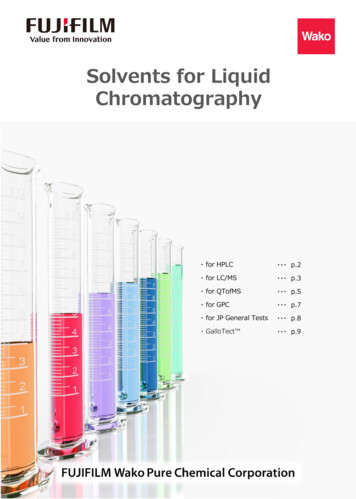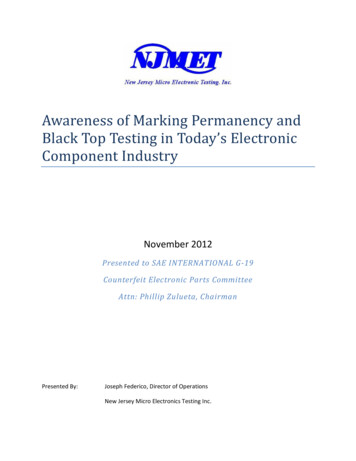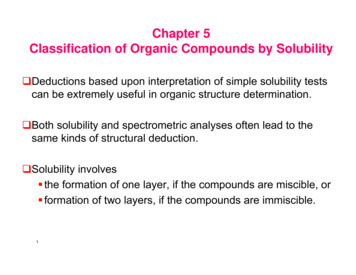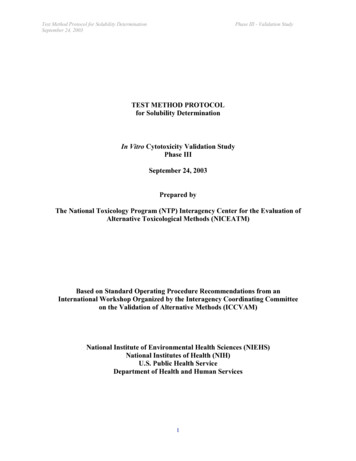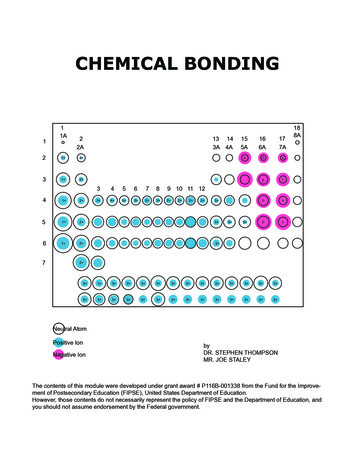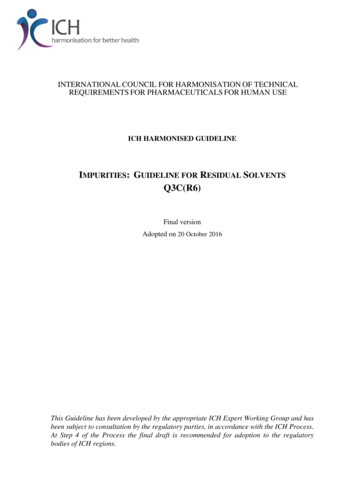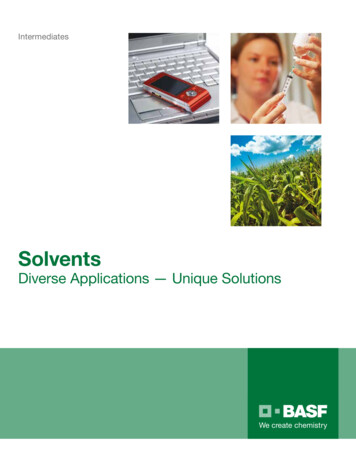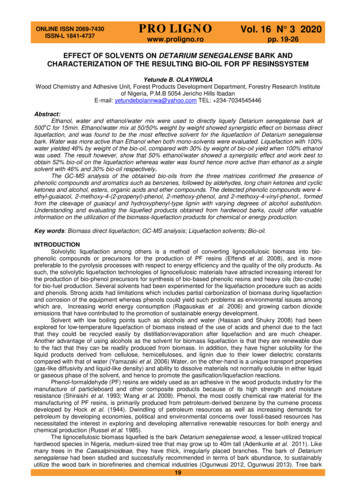
Transcription
ONLINE ISSN 2069-7430ISSN-L 1841-4737PRO LIGNOVol. 16 N 3 2020www.proligno.ropp. 19-26EFFECT OF SOLVENTS ON DETARIUM SENEGALENSE BARK ANDCHARACTERIZATION OF THE RESULTING BIO-OIL FOR PF RESINSSYSTEMYetunde B. OLAYIWOLAWood Chemistry and Adhesive Unit, Forest Products Development Department, Forestry Research Instituteof Nigeria, P.M.B 5054 Jericho Hills IbadanE-mail: yetundebolarinwa@yahoo.com TEL: 234-7034545446Abstract:Ethanol, water and ethanol/water mix were used to directly liquefy Detarium senegalense bark ato500 C for 15min. Ethanol/water mix at 50/50% weight by weight showed synergistic effect on biomass directliquefaction, and was found to be the most effective solvent for the liquefaction of Detarium senegalensebark. Water was more active than Ethanol when both mono-solvents were evaluated. Liquefaction with 100%water yielded 46% by weight of the bio-oil, compared with 30% by weight of bio-oil yield when 100% ethanolwas used. The result however, show that 50% ethanol/water showed a synergistic effect and work best toobtain 52% bio-oil on the liquefaction whereas water was found hence more active than ethanol as a singlesolvent with 46% and 30% bio-oil respectively.The GC-MS analysis of the obtained bio-oils from the three matrices confirmed the presence ofphenolic compounds and aromatics such as benzenes, followed by aldehydes, long chain ketones and cyclicketones and alcohol, esters, organic acids and ether compounds. The detected phenolic compounds were 4ethyl-guaiacol, 2-methoxy-4-(2-propenyl)-phenol, 2-methoxy-phenol, and 2-methoxy-4-vinyl-phenol., formedfrom the cleavage of guaiacyl and hydroxyphenyl-type lignin with varying degrees of alcohol substitution.Understanding and evaluating the liquefied products obtained from hardwood barks, could offer valuableinformation on the utilization of the biomass-liquefaction products for chemical or energy production.Key words: Biomass direct liquefaction; GC-MS analysis; Liquefaction solvents; Bio-oil.INTRODUCTIONSolvolytic liquefaction among others is a method of converting lignocellulosic biomass into biophenolic compounds or precursors for the production of PF resins (Effendi et al. 2008), and is morepreferable to the pyrolysis processes with respect to energy efficiency and the quality of the oily products. Assuch, the solvolytic liquefaction technologies of lignocellulosic materials have attracted increasing interest forthe production of bio-phenol precursors for synthesis of bio-based phenolic resins and heavy oils (bio-crude)for bio-fuel production. Several solvents had been experimented for the liquefaction procedure such as acidsand phenols. Strong acids had limitations which includes partial carbonization of biomass during liquefactionand corrosion of the equipment whereas phenols could yield such problems as environmental issues amongwhich are, Increasing world energy consumption (Ragauskas et al. 2006) and growing carbon dioxideemissions that have contributed to the promotion of sustainable energy development.Solvent with low boiling points such as alcohols and water (Hassan and Shukry 2008) had beenexplored for low-temperature liquefaction of biomass instead of the use of acids and phenol due to the factthat they could be recycled easily by distillation/evaporation after liquefaction and are much cheaper.Another advantage of using alcohols as the solvent for biomass liquefaction is that they are renewable dueto the fact that they can be readily produced from biomass. In addition, they have higher solubility for theliquid products derived from cellulose, hemicelluloses, and lignin due to their lower dielectric constantscompared with that of water (Yamazaki et al. 2006) Water, on the other-hand is a unique transport properties(gas-like diffusivity and liquid-like density) and ability to dissolve materials not normally soluble in either liquidor gaseous phase of the solvent, and hence to promote the gasification/liquefaction reactions.Phenol-formaldehyde (PF) resins are widely used as an adhesive in the wood products industry for themanufacture of particleboard and other composite products because of its high strength and moistureresistance (Shiraishi et al. 1993; Wang et al. 2009). Phenol, the most costly chemical raw material for themanufacturing of PF resins, is primarily produced from petroleum-derived benzene by the cumene processdeveloped by Hock et al. (1944). Dwindling of petroleum resources as well as increasing demands forpetroleum by developing economies, political and environmental concerns over fossil-based resources hasnecessitated the interest in exploring and developing alternative renewable resources for both energy andchemical production (Russel et al. 1985).The lignocellulosic biomass liquefied is the bark Detarium senegalense wood, a lesser-utilized tropicalhardwood species in Nigeria, medium-sized tree that may grow up to 40m tall (Adenkunle et al. 2011). Likemany trees in the Caesalpinioideae, they have thick, irregularly placed branches. The bark of Detariumsenegalense had been studied and successfully recommended in terms of bark abundance, to sustainablyutilize the wood bark in biorefineries and chemical industries (Ogunwusi 2012, Ogunwusi 2013). Tree bark19
ONLINE ISSN 2069-7430ISSN-L 1841-4737PRO LIGNOVol. 16 N 3 2020www.proligno.ropp. 19-26usually refers to all external tissues surrounding the vascular cambium of the tree. Generally, it takes upabout 9-15% of a typical log by volume Harkin and Rowe (1971). Bark has a similar chemical composition towood, only that it contains more extractives, higher lignin content, and a smaller amount of holocellulosethan wood. Bark phenolic composed of lignin, amorphous micromolecule, which comprises of three phenylpropanol macromolecules, namely p- hydroxy-phenylpropanol, guaiacyl-propanol and syringyl-propanol, thatcan be decomposed into the oligomeric and monomeric phenolic compounds through thermochemicaltechnology such as solvolytic liquefaction (Kleinert et al. 2009; Wang et al. 2009). In this regard,lignocellulosic bark biomass can be a source of as precursor in chemical industries.Liu and Zhang (2008), compared the effect of various solvents (water, acetone and ethanol) onpinewood (soft wood specie) liquefaction for producing fuels and chemical feedstocks. The experimentsoowere conducted in an autoclave at temperatures ranging from 250 C to 450 C for 20min with a biomass-tosolvent ratio of 1/6 (wt/wt). The results showed that the yield and composition of the liquefaction productswere greatly affected by the solvent type. The highest oil yield of 26.5wt% was obtained in ethanol. Ethanolwas favorable for the formation of 2-methoxy-4-(1-propenyl)-phenol and 2-methoxy-4-methyl-phenol, whilethe composition of bio-oil from the liquefaction using water solvent was rich in 2-methoxy-phenol, organicacids and furans. However, the focus was essentially on softwood bark because of its composition of bothguaiacyl and syringyl units derived from trans-coniferyl and trans-sinapyl alcohols. Notwithstanding, it hasbeen established that the weight percentage of lignin, cellulose, and hemicellulose in any type of biomass aswell as the composition of syringyl, guaiacyl and p-hydroxyphenyl is affected by several factors among whichare: geographical location, soil type, climatic conditions, plant species, pH level, soil nutrients and the age ofplant species (Vassilev et al. 2010). The aim of this study, therefore, is to investigate the effect of solvents onDetarium senegalense bark and characterization of the resulting bio-oil for PF resins system.MATERIALS AND METHODBARK COLLECTION AND SAMPLE PREPARATIONThe bark of Detarium senegalense was obtained from Aiyegun sawmill, New Garage, Ibadan Nigeria.Reliable information from the sawmillers was that the log was collected from Gambari Forest Reserve.oooGambari Forest Reserve which is located on latitude of 70.25 N and 7.55 E and the longitude 3.53 Noand 3.9 E within the low land semideciduous forest belt of Nigeria and covers a total land area of 17,984ha. The air-dried bark samples of D. senegalense was hammer milled using New Holland grinder model 358(New Holland, PA) with 3.175mm (1/8 In.) sieve size for particle reduction. It was then oven dried at 105 for2h. Elemental composition of carbon, hydrogen, nitrogen, and sulfur in the D. senegalense samples wasanalyzed with a CHNS Flash Elemental Analyzer 1112 series. Compositional analysis for its contents ofcellulose, hemicelluloses and lignin content was done in accordance with the TAPPI T249cm-85 (forcellulose and hemi-cellulose). The liquefaction of the hammer-milled D. senegalense bark was carried out ina 1000mL stainless steel autoclave reactor equipped with a stirrer and a water-cooling coil. Liquefactionprocedure of Chen et al. (2011) was employed.SOLVENT LIQUEFACTION OF DETARIUM SENEGALENSE BARKThe bark was hammermilled using New Holland grinder model 358, with 3.175mm (1/8 in.) sieve sizeofor particle reduction (Fig. 1). It was then oven dried at 105 C for 12hrs and kept in a desiccator at roomtemperature before use. Solvolytic Liquefaction of the hammer-milled D. senegalense bark was carried out ina 1000ml stainless steel autoclave reactor equipped with a mechancal stirrer (500rpm) and a water-coolingcoil (Fig. 2 a). The solvents used for the liquefaction were: water, ethanol and ethanol/water mix on weightto-weight basis. The solvents were used differently in each run. In a typical run, the reactor was charged with10g D. senegalense bark and 100g water or 100g ethanol or ethanol/water co-solvent 50/50%(v/v), afterwhich the reactor was sealed, and the air inside the reactor was displaced by high-purity nitrogen.oThe reactor was pressurized to 2.0MPa and heated to the desired temperature of 300 C at a steadyorate of 10 C per minute while being constantly stirred. The reaction was stopped after 30 minutes completionoof the liquefaction process. The reactor was cooled to room temperature of 25 C by means of the watercooling coil. The gaseous products (GAS) inside the reactor were thereafter vented. The resultingsuspension inside the reactor was completely rinsed with acetone and collected in a glass bowl. Thesuspension was filtered under reduced pressure through a pre-weighted Whatman No. 5 filter paper to obtainthe solid residue (SR) on the filter paper while the aqueous soluble products (AP), (Fig. 2b) consisting of biooil, in the form of liquid oily product and other non-oily liquid products were obtained as filterate. The SR andofilter paper were dried at 105 C for 2h before weighing.oThe acetone in the filtrate was then removed by rotary evaporation under vacuum (Fig. 2c) at 40 C.When co-solvent mixture of ethanol-water was used, this treatment removed the alcohol co-solvent inaddition to acetone. The remaining liquid solution was extracted with ethyl acetate. Separatory funnel wasused to separate the liquid oily products, denoted as bio-phenolic oil from water and aqueous soluble20
ONLINE ISSN 2069-7430ISSN-L 1841-4737PRO LIGNOVol. 16 N 3 2020www.proligno.ropp. 19-26oproducts (AP) (Fig. 2d). Ethyl acetate soluble phase was then evaporated under a reduced pressure at 57 Cto remove ethyl acetate; and recover the remaining aqueous soluble product (AP). Yield of bio-oil, SR wascalculated by the percentage weight of the mass of each product to the mass of the dry Detariumsenegalense bark loaded into the reactor at each run.The biomass conversion was simply calculated using (Eq. 1). Being a common challenge for thebiomass liquefaction studies, quantification of aqueous products (AP) was difficult not only because it is hardto separate the aqueous soluble products from water due to the high point boiling of water but the complexityof the aqueous products (a mixture of carboxylic acids, carbohydrates, aldehydes etc.) was also a challenge.Since our major interest in this research was the bio-oil products, the aqueous products were not analysed.MEASUREMENT OF THE BIO-OIL YIELDThe yield of the Bio-oil was quantified as:Weight of bio-oil% Bio-oil yield x 100Weight of oven-dried raw D.senegalense(1)bark before liquefactionFig. 1.Hammer-milling of D. senegalense bark of D. senegalense.a.b.c.d.Fig. 2.Liquefaction reactor (a) used to separate the liquefied fraction under vacuum (b) and subsequentseparation with the use of separatory funnel (c) to obtaining the bio-oil (d).21
ONLINE ISSN 2069-7430ISSN-L 1841-4737PRO LIGNOVol. 16 N 3 2020www.proligno.ropp. 19-26RESULTS AND DISCUSSIONSTable 1Proximate, ultimate analysis and structural compositional analysis of D. senegalense barkElemental Analysis, wt%C53.82H7.32N0.14S0.08dO36.8Structural composition, wt%bTotal e: On a dry basis; Determined by thermogravimetric analysis (TGA) in N2 at 10 C/min to 900 C; On addry and ash-free basis; By difference.dELEMENTAL CHEMICAL ANALYSIS AND STRUCTURAL CHEMICAL COMPOSITIONAL ANALYSIS OFD. SENEGALENSE BARKThe results of the elemental chemical analysis and structural chemical compositional analysis of the D.senegalense bark are presented in Table 1. The value of the percentage means for the elementalcompositional analysis the percentage composition of C, H, O, N, were 53.82%, 7.52%, 36.8% and 0.14%,respectively. Carbon had the highest value, followed by oxygen, hydrogen and then nitrogen. Thepercentage composition of sulphur was attrace level (0.08%). Likewise, for the structural chemicalcompositional analysis, the percentage by weight of cellulose, hemicelluloses and lignin were 46.2%, 18.0%and 35.2%, respectively. Cellulose has the highest percentage followed by hemicelluloses and the least waslignin. The results of the Elemental analysis of depolymerised D. senegalense bark showed that sulphur andnitrogen compounds were reduced to the barest minimum as shown in Table 2, which invariably impliessafer environmental conditions associated with products obtained from depolymerized D. senegalense bark.The nitrogen and sulphur compounds detected were likely to originate from the fuel-bound nitrogen andsulphur in the D. senegalense bark. The results fall within the range of previously reported values (Cheng etal. 2011).Table 2Detected compounds and their relative percentage area From GC-MS chromatographsRelative composition per area percentagePeak noRetentiontime/min100 % Ethanol12343.043.524.024.213.95f3.23ag3.01aaaa50 %Ethanol/Water 7aaaa2.38m2.08g100 %Waterolol22Compounds nameEthyl 2-hydroxpropanote2-FuranmenthanolBenzene, methylButanoic acid, 2-hydroxyethyl ester2-amino-2-carboxyethyldisulfanyl)-propionic acidEthanol, 2-(ethenyloxy)Benzene (1- methylethl)Propanoic acid, 2-hydroxyethyl esterPiperazineMethoxy -1-CyclopentenePropanoic acid ,2-hydroxy-,methyl ester
ONLINE ISSN 2069-7430ISSN-L 1841-4737PRO LIGNOVol. 16 N 3 2020www.proligno.ropp. 48nkpjahaa2-FurancarboxaldehydeBenzene, (1-methylethyl)-Butanoic anhydridePhenol, 2-methoxy-furancarboxaldehyde, 5methyl1-hydroxy-2-methoxy-4methylbenzeneBenzene (1- methylethl)-methyl-1,2cyclopentanedioneEthanone, 1-(5-methyl-2furanyl)Pentanoic acid ,4-oxo-,ethylesterPhenol, 2-methoxyGuaiacol,4-methoxyFormamide, n -2carboxy-ethyldisulfanyl)Propanoic acidPhenol, nzeneGuaiacol, 4-propyl-furancarboxaldehyde, 5(ethoxymethyl)Phenol, 2-methoxy-4-(2propenyl)Guaiacol, 4-ethyltetrahydro-pyran-3-olBenzaldehyde, 4-hydroxy-3methoxy- Benzenemethanol,-4hydroxy- alpha [(methylamino)methyl]Phenol, 2-methoxy-4-(2propenyl)Ethanone, 1-(4-hydroxy-3methoxyphenl)2-propanone, thylpropyl acetateTotal area %94.62 %83.65 %96.11%aNot including the small peaks with an area less than 2 % of the total area.CHEMICAL COMPOSITIONAL CHARACTERIZATION OF BIO-OIL OBTAINED FROM THE SOLVOLYSISLIQUEFACTION USING ETHANOL, WATER, AND ETHANOL/WATER MIXThe chemical compounds as identified using the WILEY8 library based on the GC-MSchromatographs. The detected compounds and their relative percentage area for the major compounds aresummarized in Table 2. The relative percentage area for each compound was defined by the percentage ofthe chromatographic area of the specific compound out of the total area of 50 largest identified peaks. The23
ONLINE ISSN 2069-7430ISSN-L 1841-4737PRO LIGNOVol. 16 N 3 2020www.proligno.ropp. 19-26major compounds identified in the bio-oil products were phenolic compounds, benzenes, aldehyde, longchain and cyclic ketones, alcohols, esters, carboxylic acids and ether compounds.Fig. 3.Effect of solvent types: 100% Ethanol, 100%Water and 50/50% (weight by weight) Ethanol/Water mixoon the yield of Bio-oil from the liquefaction at 300 C while the solvent-to-biomass ratio was fixed at10:1 (wt/wt).EFFECT OF SOLVENT TYPES: ETHANOL, WATER AND ETHANOL/WATER MIX (WT/WT) ONPERCENTAGE BIO-OIL YIELDThe results of the effect of solvent types: ethanol, water and 50/50% weight by weight ethanol/wateromix on the yield of bio-oil from the liquefaction at 300 C at solvent-to-biomass ratio of 10:1 (wt/wt), areshown in Fig. 3. As a single solvent, water provided better bio-oil yield (46%) than ethanol (30%); however,50% wt/wt ethanol gave the best yield of 52%. Water was more active than Ethanol when both monosolvents were evaluated. Liquefaction with 100% water yielded 46% by weight of the bio-oil, compared with30% by weight of bio-oil yield when 100% ethanol was used. The result however, show that 50/50% (weightby weight) ethanol/water mix for the solvolytic liquefaction of D. senegalense bark yielded 52% bio-oil andwas therefore much more effective than mono-solvent of either water or ethanol. The result was almostsimilar with the work of Cheng et al. (2010), where white pine sawdust was effectively liquefied in 50wt%ethanol-water medium, producing approximately 66wt% bio-oil. The difference in the yield from the testedsolvents could be due to the fact that alcohols are slightly weaker acids than water. However, water in hotcompressed and sub-critical state has a number of special properties: a lower dielectric constant, fewer andweaker hydrogen bonds, a higher isothermal compressibility and an enhanced solubility for organiccompounds than ambient liquid water (Savage 1999; Akiya and Savage 2002). As a result, the lower activityof the 100wt% ethanol for biomass liquefaction than that of 100% water may be expected. Also, hotcompressed water had been demonstrated to be an effective solvent for biomass hydrothermal liquefaction(Matsumura et al. 1999; Karagoz et al. 2004, 2005; Xu and Lad 2008). It has also been found to be veryeffective for promoting ionic, polar non-ionic and free-radical reactions which make it a promising reactionmedium for biomass direct liquefaction. Ethanol, however, could reduce the surface tension of the liquefiedproducts and, hence, improve the diffusion of solvent to the lignin matrix. Ethanol, has also, been reported tohave the ability to readily dissolve relatively high-molecular-weight liquid products/intermediates derived fromcellulose, hemicelluloses, and lignin because of their lower dielectric constants when compared to that ofwater (Miller et al. 1999, Ogi et al. 1993). The lower yield of bio-oil in pure ethanol than water however, couldbe due to limited hydrolysis reaction.However, from Fig. 3, 50% wt/wt. co-solvent of ethanol-water was a much effective solvent than anyconstituent mono-solvent. These results strongly suggested synergistic effect on biomass direct liquefactionobserved when the co-solvent of ethanol and water produced a higher yield of bio-oil as previously reportedby (Pasquini et al. 2005; Li and Kiran 1988) in organic solvent (organosolv) delignification of woody biomassoat 190 C where 50% methanol to water solution or 50% ethanol to water solution was found to be veryeffective for wood delignification. The co-solvent of ethanol to water has attracted more interests, simplybecause ethanol is a renewable resource, which can be obtained readily by fermentation of sugar.24
ONLINE ISSN 2069-7430ISSN-L 1841-4737PRO LIGNOVol. 16 N 3 2020www.proligno.ropp. 19-26CONCLUSIONThe research revealed that the lignin in D. senegalense bark is composed of both guaiacyl andsyringyl unit with small amount of p-hydroxyphenyl unit derived from transconiferyl and trans-sinapyl alcoholwhich could decompose into guaiacyl and hydroxyphenyl-type phenolic products during the liquefactionprocess. Ethanol and water showed synergistic effect on biomass direct liquefaction, and the 50wt% cosolvent of ethanol-water was found to be the most effective solvent for the liquefaction of Detariumsenegalense bark.REFERENCESAdekunle A, Afolayan A, Okoh B, Omotosho T, Pendota C, Sowemimo A (2011) Chemical composition,antimicrobial activity, proximate analysis and mineral content of the seed of Detarium senegalense J.F Gmel.African Journal of Biotechnology, 10(48):9875-9879.Akiya N, Savage PE (2002) Roles of water for chemical reactions in high-temperature water. ChemistryReview, 102:2725-2750.Alma MH, Yoshioka M, Yao Y, Shiraishi N (1995a) Upgrading bitumen in supercritical fluids. MokuzaiGakkaishi, 41:741-748.Alma MH, Yoshioka M, Yao Y, Shiraishi N (1995b) Preparation of sulfuric acidcatalyzed phenolated woodresin. Journal of Wood Science Technology. 30:39-47.Alma MN (1996) Several acids-catalysed phenolation of wood and its applications to molding materials. Ph.D. Dissertation. Kyoto University. Kyoto, Japan.Alma MH, Maldas D, Shiraishi N (1997) Liquefaction of several biomass wastes into phenol in the presenceof various alkalies and metallic salts as catalysts. Journal of Polymer Engineering. 18:163.Alma MH, Yoshioka M, Yao Y, Shiraishi N (1998) Preparation of sulfuric acid-catalyzed phenolated woodresin. Wood Science Technology, 32:297-308.Alma MH, Basturk MA (2006) Liquefaction of grapevine cane (Vitisvinisera L.) waste and its application tophenol-formaldehyde type adhesive. Journal of Industrial Crops Products. 24:171-176.Amen-Chen C, Pakdel H, Roy C (2001) Production of monomeric phenols by thermochemical conversion ofbiomass: a review. Journal of Bioresource Technolology, 79:277-299.Cheng S, D‘cruz I, Wang M, Leitch M, Xu C (2010) Highly efficient liquefaction of woody biomass in hotcompressed alcohol-water co-solvents. Energy Fuel 24(9):4659-4667. “Critical literature review ofrelationships between processing parameters and physical”.Cheng S, D‘Cruz I, Yuan Z, Wang M, Anderson M, Leitch M, Xu C (2011) Using bio-crude derived fromwoody biomass to substitute for phenol at a high substitution level for production of bio-based phenolic resolresins. Journal of Applied Polymer Science.121:2743-2751.Effendi A, Gerhauser H, Bridgwater AV (2008) Production of renewable phenolic resins by thermochemicalconversion of biomass: A review. Renewable and Sustainable Energy Reviews, 12(8):2092-2116.Hassan EM, Shukry N (2008) Polyhydric alcohol liquefaction of some lignocellulosic agricultural residues.Industial Crops Production, 27:33-38.Karagoz S, Bhaskar T, Muto A, Sakata Y (2004) Effect of Rb and Cs carbonates for production of phenolsfrom liquefaction of wood biomass. Fuel. 83:2293-2299.Karagoz S, Bhaskar T, Sakata Y (2005) Comparative studies of oil compositions produced from sawdust,rice husk, lignin and cellulose by hydrothermal treatment. Fuel. 84:875-884.Kleinert M, Barth T (2008) Phenols form lignin, Chemical Engineering Technology. 31:736-745.Li L, Kiran E (1988) Interaction of supercritical fluids with lignocellulosic materials. Industrial EngineeringChemical Resources. 27:1301-1312.Lin LZ, Yoshioka M, Yao YG, Shiraishi N (1994) Liquefaction of wood in the presence of phenol usingphosphoric acid as a catalyst and the flow properties of the liquefied wood. Journal of Applied PolymerScience. 52:1629-1636.Lin LZ, Yoshioka M, Yao YG, Shiraishi N (1995) Preparation and properties of phenolated wood/phenol/formaldehyde cocondensed resin. Journal of Applied Polymer Science, 58:1297-1304.25
ONLINE ISSN 2069-7430ISSN-L 1841-4737PRO LIGNOVol. 16 N 3 2020www.proligno.ropp. 19-26Liu Z, Zhang F (2008) Effects of various solvents on the liquefaction of biomass to produce fuels andchemical feedstocks. Energy Conversation Management 49:3498-3504.Matsumura Y, Nonaka H, Yokura H, Tsutsumi A, Yoshida K (1999) Co-liquefaction of coal and cellulose insupercritical water. Energy Fuel. 78:1049-1056.Miller JE, Evans L, Littlewolf A, Trudell DE (1999) Bath microreactor studies of lignin and lignin modelcompound depolymerization by bases in alcohol solvents. Energy Fuel. 78:1363-1366.Ogi T, Yokoyama S (1993) Liquid fuel production from woody biomass by direct liquefaction. SekiyuGakkaishi, 36:73-84.Ogunwusi AA (2012) “Wood properties of Detarium senegalense, a lesser used tropical timber growing inNigeria,” Journal of Biology, Agriculture and Healthcare. 2(10).Ogunwusi AA (2013) “Variation in the percentges of bark of ten tropical hardwood specie grown in Nigeria,”Journal of life sciences ant Technology; Vol 7:224-7181.Ohra-aho T, Tenkanea M, Tamminen T (2005) Direct analysis of lignin analysis lignin-like component fromsoftwood kraft pulp by Py-GC/MS techniques. Journal of Analytical Pyrolysis, 74:123-128Pasquini D, Pimenta MTB, Ferreira LH, Curvelo AAS (2005) Extraction of lignin from sugarcane bagasse andPinus taeda wood chips using ethanol–water mixtures and carbon dioxide at high pressures. JournalSupercritical Fluids. 36:31-39.Ragauskas AJ, Williams CK, Davison BH, Britovsek G, Cairney J, Eckert CA, Frederick WJJr, Hallett JP,Leak DJ, Liotta CL (2006) The path forward for biofuels and biomaterials. Science 2006, 311:484-489.Russell JA, Riemath WF (1985) Method for making adhesive from biomass. US Patent 4 508 886, USA asrepresented by the United States Department of Energy.Savage PE (1999) Organic chemical reactions in supercritical water. Chemical Review: 603621.Shiraishi N, Shirakawa K, Kurimoto Y (1992) Japanese Pat Appl. 106-128.Vassilev SV, Baxter D, Andersen LK, Vassileva CG (2010) An overview of the chemical composition ofbiomass. Fuel 89:913-933.Wang M, Leitch M, Xu C (2009) Synthesis of phenol-formaldehyde resol resins using organosolv pine lignins.Euroupean Polymer Journal, 12(45):3380-3388.Xu C, Lad N (2008) Production of heavy oils with high caloric values by direct liquefaction of woody biomassin sub-/near-critical water. Energy Fuel. 22:635-642.Xu C, Etcheverry T (2008) Hydro-liquefaction of woody biomass in sub- and supercritical ethanol with ironbased catalysts. Energy Fuel. 87(3):335-345.Yamazaki J, Minami E, Saka S (2006) Liquefaction of beech wood in various supercritical alcohols. JournalWood Science. 52:527-532.26
The bark of Detarium senegalense was obtained from Aiyegun sawmill, New Garage, Ibadan Nigeria. Reliable information from the sawmillers was that the log was collected from Gambari Forest Reserve. Gambari Forest Reserve which is located on latitude of 70.25 o N and7.55 o E and the longitude 3.53 o N
